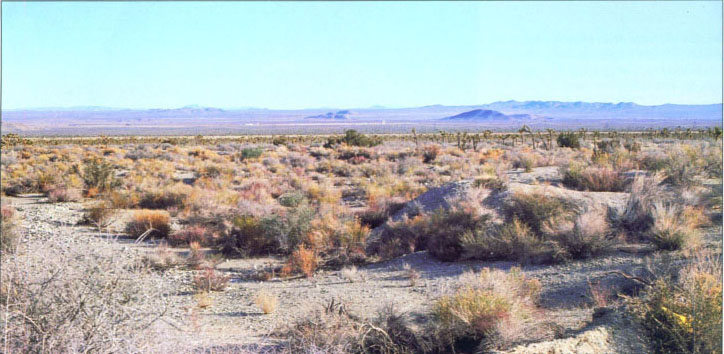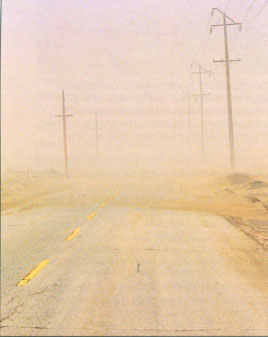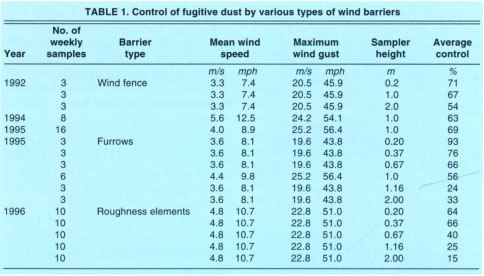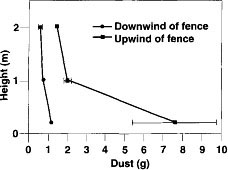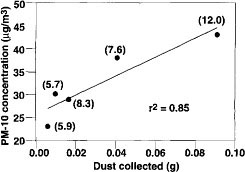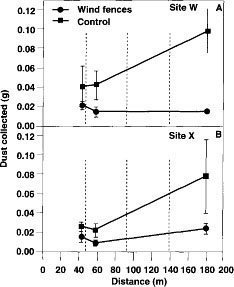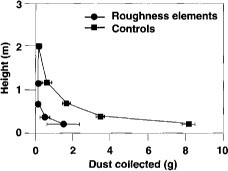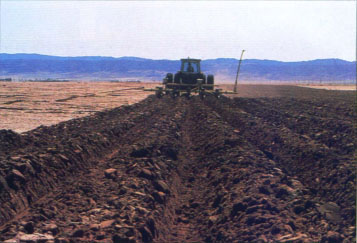All Issues
Wind barriers offer short-term solution to fugitive dust
Publication Information
California Agriculture 52(4):14-18. https://doi.org/10.3733/ca.v052n04p14
Published July 01, 1998
PDF | Citation | Permissions
Abstract
Wind-blown fugitive dust is a widespread problem in the arid west resulting from land disturbance or abandonment and increasingly limited water supplies. Soil-derived particles obstruct visibility, cause property damage and contribute to violations of health-based air quality standards for fine particles (PM-10). These dry lands are often difficult to revegetate, yet they may require immediate stabilization. We evaluated the effectiveness of three types of mechanical wind barriers, which can be Installed more rapidly and more reliably than revegetation, in suppressing dust emissions. Wind fences, furrows and scattered roughness elements, such as plastic cones, are shown to reduce fugitive dust emissions in areas of the Mojave Desert that resisted revegetation.
Full text
About 25% vegetative cover is typical for the western Mojave Desert, and is sufficient to prevent soil losses from wind erosion.
Dust storms, like this one pictured along a county road in the Antelope Valley, have led to serious traffic accidents and violations of air quality standards.
The western United States is characterized by large areas of arid and semiarid land. Following disturbance by construction, agriculture or recreational activities, these lands are subject to wind-driven emissions of fugitive dust. Population expansion, rising demand for limited water resources and increased pumping costs are increasing the extent of fallow and abandoned arid and semiarid land subject to such wind erosion.
As the forces exerted by the wind overcome the forces that bind soil particles to the surface, soil loss occurs. Dislodged soil particles may roll across the surface (creep), or they may bounce (saltation), dislodging further particles with each impact. This process leads to a cascade effect resulting in massive emissions of dust. Fugitive dust affects crops and native vegetation by abrading and burying plants and by blocking sunlight. Blowing dust has also caused traffic accidents in California's Central Valley and in the Antelope Valley of the western Mojave Desert.
Fugitive dust was measured with BSNE passive samplers that collected suspended particles larger than about 45 microns in aerodynamic diameter.
Wind fences provided effective control of blowing fugitive dust in areas with over-blown sand that resisted revegetation efforts.
Theoretical relationships between saltation activity of coarse particles and vertical fluxes of fine particles emitted from the surface suggest that control of wind erosion in arid and semiarid regions helps to reduce fugitive emissions of soil-derived fine particles, and also mitigates violations of health-based National and State Ambient Air Quality Standards for particulate matter (PM-10 and PM-2.5). These fine particles, with aerodynamic equivalent diameters of 10 and 2.5 micrometers and much finer than a human hair, are drawn deeply into the lung, where they may be associated with adverse health effects.
Roughness elements — such as wind fences, shrub vegetation, furrows, rocks and soil aggregates — absorb wind energy, disrupt movement of sand grains and reduce particulate emissions. In this study, we evaluated the effectiveness of a number of mechanical barriers.
Western Mojave Desert
The Antelope Valley is an arid region that is subject to periodic high-wind events and emissions of fugitive dust. Formerly a high-quality agricultural area with artesian wells and low-cost groundwater resources, it is now undergoing a slow process of urbanization and agricultural withdrawal. Land abandonment, off-road vehicle usage, extensive sheep grazing and increased incidence of wildfire have all contributed to the expansion of severely disturbed areas without stable perennial vegetation. These areas are subject to emissions of fugitive dust. Native vegetation in this area covers about 25% of the surface of undisturbed land, and is sufficient to prevent such wind erosion. Following disturbance, the stabilizing soil crust is disrupted and native perennial plant species are replaced by ephemeral annual species such as Russian thistle (Salsola pestifer; tumbleweed), mustards and grasses. These leave the surface periodically barren, and the resulting seasonal erosion further destabilizes the surface and prevents perennial shrub establishment, perpetuating a cycle of disturbance.
During the prolonged drought of 1985 to 1992, the metropolitan areas of Lancaster and Palmdale and the unincorporated area of Antelope Acres were inundated with wind-blown fugitive dust and fine particulate matter emitted from disturbed upwind areas of the Antelope Valley. In 1989, 1990 and 1991, the South Coast Air Quality Management District reported 25, 22 and 11 exceedances of the California State standard for PM-10 (50 μg/m3, 24-hour average), with a maximum 24-hour average of 780 μg/m3, occurring in 1991. In response to the increasing severity of wind-blown dust and persistent particulate air quality violations, a locally based multiagency working group, the DustBusters Taskforce, was convened to consider mitigation strategies.
Fig. 1. Effect of wind fences on the vertical distribution of suspended fugitive dust, relative to the area upwind of the wind fences (squares). Wind speed at 2.0 m averaged 2.7 m/s (6 mph) during this 7-day sample period, with gusts up to 15.2 m/s (34 mph).
Fig. 2. Atmospheric concentrations of PM-10 measured with a high volume sampler were significantly related to collections of dust at 2.0 m with the BSNE samplers. Data are 48-hour samples under varying conditions of mean wind speed (mph in parentheses).
An Emergency Watershed Protection (EWP) program was funded by the USDA Soil (now Natural Resources) Conservation Service (NRCS). The EWP revegetation program was the first NRCS program of its kind to target wind erosion. About 2,500 acres of the most seriously disturbed lands were treated with the EWP protocol of furrowing and revegetation. Areas within the EWP area that were overburdened with drifting sand did not respond to the furrowing and seeding. In these areas, wind fences were installed along roadways and upwind of threatened residential areas.
In the EWP area and in surrounding areas of experimental plots, we evaluated the effectiveness of these wind fences erected across the prevailing wind. We also evaluated the effectiveness of widely spaced, discrete “roughness elements” consisting of plastic cones, and of furrows installed across the wind, in reducing fugitive dust emissions from extensive areas of disturbed land. These techniques have the capability to provide rapid surface stabilization in areas where vegetation is absent and difficult to reestablish.
Particle sampling
Suspended coarse particulate matter, dust, was sampled with passive collectors (BSNE samplers), which efficiently collected coarse suspended particles larger than about 45 microns in aerodynamic equivalent diameter. The BSNE samplers were deployed at several heights on 10-foot lengths of pipe driven into the soil. The mass of dust collected in the BSNE samplers was determined on a regular schedule.
We evaluated airborne concentrations of PM-10 at one location with a USEPA reference method High Volume Sampler with a 10-micron Size Selective Inlet located 6.6 feet (2.0 meters) above the surface. This was co-located with two BSNE samplers at the same height.
To evaluate contrasting barrier techniques, we compared dust collected upwind and downwind of the barriers, or dust collected downwind of treated and untreated areas.
Wind fences
In spring 1992, three parallel wind fences (4-foot height, 55% porosity) of ultraviolet-stabilized plastic tied to T-stakes were established 33 feet apart, perpendicular to prevailing winds, on a 60-acre area of Cajon loamy sand with overlying wind-blown sand with 1,500 feet fetch of uniform disturbed surface. This intensive grouping of fences was designed to protect a specific down-wind group of residential buildings. A duplicate array of BSNE samplers, at heights of 0.7, 3.8 and 6.6 feet (0.2, 1.0 and 2.0 meters), was deployed along this fetch in a transect from a stable region of natural vegetation at the upwind boundary, through the unconsolidated sandy area containing the wind fences, to the leeward edge.
We collected samples at weekly intervals over an evaluation period of approximately 3 months. Wind speeds ranged from calm to gusts of over 45 mph. During a period of moderate maximum wind velocity near 33 mph, resulting in significant dust collections upwind of the fences, the wind fences significantly decreased fugitive emissions by about 80% near the ground and about 60% at 1.0 and 2.0 meters (fig. 1). When averaged over three weekly sample periods (two periods in April and one in May 1992) that yielded substantial fugitive dust collections, the wind fences exerted greater than 50% control at all measurement heights (table 1). The balance of the sampling periods in spring 1992 were characterized by relatively calm winds with low emissions of fugitive dust. These same fences were evaluated in spring 1994, yielding nearly identical results at the 1.0 meter height (table 1).
The collections of coarse dust by the BSNE samplers in 1992 were strongly related to airborne concentrations of fine particles determined with the High Volume PM-10 Sampler (fig. 2). This supports the suggestion that control of wind erosion may mitigate violations of air quality standards for fine particles, at least under the low-wind conditions of this comparison.
In 1994, we also evaluated identical wind fences at a different abandoned agricultural site that was overburdened with much deeper, drifting wind-blown sand. At two locations, we established less intensive groupings of three single wind fences, 164 feet (50 meters) apart, perpendicular to the prevailing wind to evaluate a potential control measure for extensive areas, where a dense network of barriers would be cost prohibitive.
The widely spaced fences disrupted the fetch at periodic intervals. Although emissions from the control plots increased substantially with increasing downwind fetch, those from the plots treated with wind fences did not (fig. 3). Collection of suspended dust was reduced at all points along the plot at the 1.0-meter measurement height, even just upwind of the first fence.
Fig. 3. Effect of wind fences (vertical broken lines) on the relationship between fetch across a disturbed surface and fugitive dust collections at 1.0 m in adjacent plots with (circles) or without wind fences. Data are means of three sample periods, at replicate locations with an overburden of sand in the western Antelope Valley. Wind speed at 2.0 m averaged 6.1 m/s (13.6 mph) with gusts up to 24.2 m/s (54 mph).
Fig. 4. Effect of widely dispersed roughness elements (circles) on the vertical distribution of suspended fugitive dust relative to a similar area without roughness elements. Wind speed at 10 m averaged 8.0 m/s (18 mph) during this 7-day sample period, with gusts up to 23 m/s (51 mph).
Wind fences were effective in reducing fugitive dust at all of the test sites in all years (table 1). Averaged over all periods and locations, including calm periods of low fugitive dust emissions, the wind fences reduced suspended particles by about 66% at 1.0 meters, although the effectiveness was greater during periods of high wind. Wind fences require an initially large input of labor and materials, but they provide an immediately effective and persistent method of controlling wind-blown fugitive dust.
Furrows
Furrowing is commonly used for controlling wind erosion in arid as well as more mesic environments. The resulting complex and rough soil surface exposes more aggregated particles to the wind and increases the wind speed required to initiate particle movement. Dislodged particles also become trapped in wind-protected locations, suppressing saltation and interrupting the chain reaction that leads to massive dust emissions.
We established furrows across the wind on a 328-by-656-foot barren site of Hesperia fine sandy loam with an adjacent control plot. Replicate BSNE samplers were installed at several heights up to 6.6 feet (2 meters) (n = 3 per height) at the downwind edge of each plot. The furrows reduced fugitive dust collections at all heights (table 1), ranging from a 93% reduction near the soil surface to a 24% to 33% reduction above 1.0 meter. The furrows significantly increased the threshold friction velocity, a measure of wind speed needed for dust emissions, from about 45 to about 65 cm/s. Heavy soils that readily form aggregates are more likely than sandy soils to respond to a furrowing treatment. In situations of arable soil overburdened with windblown sand, furrowing may be ineffective, while deep ripping may be effective in bringing large aggregates to the surface and reducing dust emissions.
Furrowing is commonly used to control wind erosion, by exposing aggregates, making the surface rougher and requiring higher wind speeds to initiate particle movement.
The common agronomic practice of furrowing across the wind was successful in rapidly reducing fugitive dust and soil erosion from this fallow field in the Antelope Valley. However, a general disadvantage of such tillage in the Antelope Valley and other arid areas is that it discourages establishment of desirable native perennial shrubs such as Atriplex spp. and rabbitbrush (Chrysothamnus nauseosus), and encourages invasion by nitrophilic annuals such as Russian thistle. Nevertheless, the rapid stabilization of furrowing may promote revegetation of some highly unstable sites, because continual surface erosion also inhibits shrub establishment.
Dispersed barriers
After we evaluated furrowing, we lightly disked the same treated and control plots to a uniform surface free of annual species. The control plot remained in a barren condition while plastic cones (base diameter 8 inches, top diameter 4 inches, height 24 inches) were dispersed approximately on a grid of 7.5 by 30 feet over the entire plot. We evaluated the effectiveness of these dispersed roughness elements in suppressing fugitive dust weekly with replicate BSNE samplers at five heights downwind of each plot.
The dispersed roughness elements significantly reduced fugitive dust emissions, especially near the soil surface, during a high-wind collection period (fig. 4). The reduced fetch between the barriers reduced the wind speed near the ground, decreased the mass of particles in saltation, and minimized entrainment into the bulk airstream. Over 10 weekly sampling periods, dust collections were reduced by about two-thirds near the ground, but only by about 15% at 6.6 feet (2.0 meters) (table 1).
Discrete roughness elements, such as these small plastic cones used for herbivory protection of transplanted seedlings, disrupt wind flow patterns at the soil surface and help reduce fugitive dust emissions.
Although these plastic cones were initially selected as plant shelters for revegetation efforts, their effectiveness in reducing dust emissions despite the complete failure of plant establishment suggests that many types of discontinuous roughness elements could provide rapid relief from dust emissions. If they are unsightly or nondegradable, such objects could be removed once revegetation becomes established.
All wind barriers effective
We evaluated a variety of nonvegetative wind barriers under contrasting conditions in a severely disturbed arid region.
Wind barriers of all types were effective in controlling fugitive dust emissions from areas that were resistant to long-term revegetation. Furrows installed perpendicular to the prevailing winds reduced emissions by more than 50% at heights up to 3.3 feet (1.0 meter), but the surface disturbance associated with tillage was not conducive to natural shrub establishment. Wind fences installed perpendicular to the prevailing winds were also effective in reducing saltation near the soil surface and in reducing suspended particles downwind of the fences by approximately 90% under high-wind conditions. Wind fences are costly to install, but they provide persistent suppression of wind-blown dust, at least until local deposition buries the fence. Widely spaced, individual, dispersed roughness elements were also effective in reducing fugitive dust emissions.
Although natural or facilitated revegetation with native shrubs is likely to be even more effective and sustainable than the artificial wind barriers evaluated here, revegetation may not be feasible at all sites nor achievable in a timely fashion. Therefore mitigation of soil erosion and particulate air pollution in arid and semiarid regions requires land managers and the regulatory community to explore a full range of vegetative and mechanical mitigation strategies.



